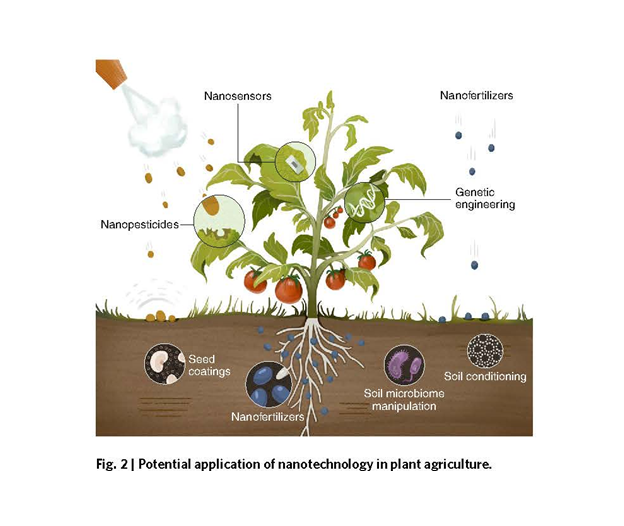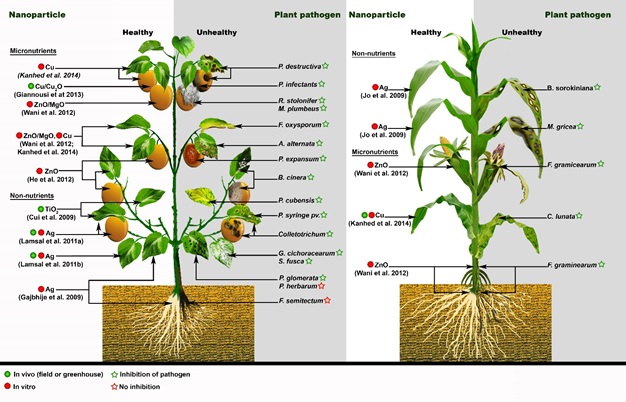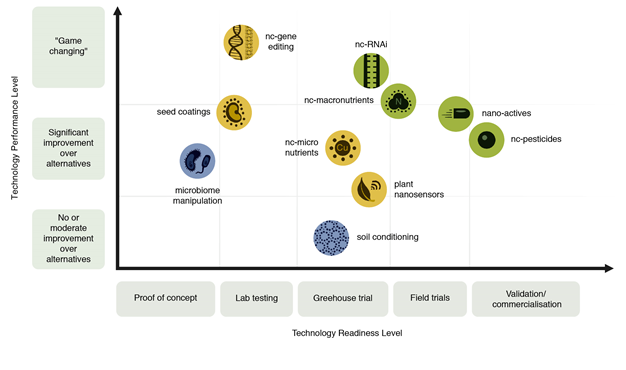The Center for Nanoscale Sulfur Research (CeNaSR)
Background
This Center of Excellence is the product of a USDA AFRI Foundational Program Grant Award 2020-67022-32416 in the Agriculture Systems and Technology Program Area, specifically: Program Area Priority Code A1511 “Nanotechnology for Agricultural and Food Systems.” The grant title is “Nanoscale sulfur for plant nutrition, disease suppression and food safety.” The project dates are September 1, 2020-August 31, 2023.
Center Investigators
Project Director (PD)- Jason C. White, Ph.D.
Director
The Connecticut Agricultural Experiment Station
123 Huntington Street
New Haven, CT 06511
Phone: 203-974-8440
Co-Project Director (CoPD)- Wade Elmer, Ph.D.

Vice Director and Chief Scientist
Department of Plant Pathology and Ecology
The Connecticut Agricultural Experiment Station
123 Huntington Street
New Haven, CT 06511
Phone: 203-974-8503

CoPD- Om Parkash Dhankher, Ph.D.
Stockbridge School of Agriculture
320 Paige Laboratory
University of Massachusetts
Amherst, MA 01003
Phone: 413-545-0062
 CoPD- Baoshan Xing, Ph.D.
CoPD- Baoshan Xing, Ph.D.
Stockbridge School of Agriculture
410 Paige Laboratory
University of Massachusetts
Amherst, MA 01003
Phone: 413-545-5212
CAES Post-doctoral Associate
 Yi Wang, Ph.D.
Yi Wang, Ph.D.
Department of Analytical Chemistry
The Connecticut Agricultural Experiment Station
123 Huntington Street
New Haven, CT 06511
Email- Yi.Wang@ct.gov
UMass Graduate (Ph.D.) Student

Sudhir Sharma
Stockbridge School of Agriculture
317 Paige Laboratory
University of Massachusetts
Amherst, MA 01003
Phone: 413-406-0317
UMass Graduate (Ph.D.) Student
 Ahmed Ali
Ahmed Ali
Stockbridge School of Agriculture
317 Paige Laboratory
University of Massachusetts
Amherst, MA 01003
UMass Graduate (Ph.D.) Student
 Gurpal Singh
Gurpal Singh
Stockbridge School of Agriculture
317 Paige Laboratory
University of Massachusetts
Amherst, MA 01003
Phone: 413-923-1582
Other Team Members
 D. Venkataraman, Ph.D.
D. Venkataraman, Ph.D.
Professor
Advanced Laboratory for Iontronic, Electronic,
and Nanomaterials (ALIEN)
Department of Chemistry
University of Massachusetts Amherst
MA 01003
Phone: 413-545-2028
Mr. Craig Musante
Assistant Scientist I
Department of Analytical Chemistry

The Connecticut Agricultural Experiment Station
123 Huntington Street
New Haven, CT 06511
Phone: 203-974-8454
Christian Dimkpa, PhD
 Head and Chief Scientist
Head and Chief Scientist
Department of Analytical Chemistry
The Connecticut Agricultural Experiment Station
123 Huntington Street
New Haven, CT 06511
International Collaborators
 Prof. Dr. Zhenyu Wang
Prof. Dr. Zhenyu Wang
Dean, School of Environment and Civil Engineering
Director, Institute of Environmental Processes and
Pollution Control
Jiangnan University, Wuxi, China, 214122
http://building.jiangnan.edu.cn/info/1214/4112.htm

 Nelson Marmiroli, Ph.D. and Elena Maestri, Ph.D.
Nelson Marmiroli, Ph.D. and Elena Maestri, Ph.D.
Department of Chemistry, Life Sciences and
Environmental Sustainability
University of Parma
Parco Area delle Scienze 33A
43124 Parma, Italy
(+39)0521905606, nelson.marmiroli@unipr.it
(+39)0521905687, elena.maestri@unipr.it
 Helmi Hamdi, Dr. Agr. Eng. Habil
Helmi Hamdi, Dr. Agr. Eng. Habil
Food and Water Security Program
Center for Sustainable Development
College of Arts and Sciences
Qatar University, Doha, Qatar
+974 44037574
USDA Grant: Project Summary
Project Summary: With a projected global population of 9.7 billion by 2050, agricultural production will need to increase by up to 70%, making achieving global food security among the most significant challenges we face. Further confounding this effort is that the growth in food production will have to occur in the face of a changing climate and on decreasing arable land. Ideally, strategies driving this effort will need to be sustainable, efficiently using water and energy while minimizing negative environmental impacts. One major shortcoming of current agricultural practices is the high inefficiency of agrochemical delivery and utilization, with losses averaging 10-90%. As such, there has been rapidly growing interest in using nanotechnology to address these inefficiencies. Current approaches have focused on nano-enabled conventional agrichemicals, nanosensors, and waste treatment strategies. Nano-enabled agricultural strategies will be incredibly complex and will certainly not be a single “silver” bullet. However, it is clear that efficient, multi-functional strategies to promote food production are needed.
In the literature, it is clear that although bulk/chelated sulfur has been used in agriculture for some time, little is known about the potential of nanoscale sulfur as an agricultural amendment. Sulfur is known to be pivotal in disease resistance through activation of defense barrier production and by its role in the glutathione pathway of stress response. However, the use of sulfur at the nanoscale remains largely unexplored. The goal of this project is to use nanoscale sulfur as a novel multifunctional agricultural amendment. Based on preliminary data, our central hypothesis is that nanoscale sulfur can be used to strategically enhance yield, suppress disease, and improve food safety by reducing heavy metal uptake. Our three objectives are:
Obj.1- Demonstrate the efficacy of nanoscale sulfur as a novel fertilizer for promoting crop
growth and yield.
Obj.2- Demonstrate the potential of nanoscale sulfur for crop disease suppression.
Obj.3- Demonstrate the use of nanoscale sulfur for preventing heavy metal uptake in crops.
We will use commercial and in-house synthesized nanosulfur of different sizes and coatings in greenhouse and field trials as a novel fertilizer for rice, wheat, soybean, tomato, lettuce and carrot. Greenhouse trials will include hydroponic designs relevant to increased interest in urban agriculture. The efficacy of nanoscale sulfur for suppressing crop disease and promoting health through defense activation will be evaluated in three disease systems, soybean with Fusarium and tomato with either bacterial spot (Xanthomonas) or Fusarium. Last, nanosulfur will be investigated as an amendment to minimize As and Cd uptake by rice and wheat, respectively. Although NP use in agriculture is increasing, the stresses from an increasing population and changing climate require novel strategies for sustainably enhancing food production. Novel multifunctional approaches such as that of nanoscale sulfur to promote growth, suppress disease and minimize metal contamination have great potential to maximize agricultural output. The multidisciplinary team of investigators will establish a Center of Excellence that will deploy a unique combination of educational and dissemination strategies to engage a range of stakeholders in this project.
|
Nanotechnology has great opportunities to improve plant agriculture. Nanopesticides might have a higher efficacy and help to prevent runoff to surface and ground water. Nanotechnology-based genetic engineering might offer tremendous advantages compared to classical techniques. Plants could be used as sensors to provide information about their nutritional or health status. Nanotechnology might be used to modify the soil microbiome or be used in soil conditioning, and nano-carrier bound fertilizers might be more efficient than conventional products. Nano-enabled coatings might improve seed quality. (Hoffman et al. 2020. Moving forward responsibly in nanotechnology enabled plant agriculture. Nature Food, 1, 416–425). |

|
Effect of nanoparticle elements on crop disease. (Servin et al. 2015. A review of the use of engineered nanomaterials to suppress plant disease and enhance crop yield. J. Nano. Res. DOI: 10.1007/s11051-015-2907-7). |

|
Technology readiness level (TRL) for proposed application areas or approaches for nano-enabled technologies that can benefit agriculture. The TRL was determined based on available data regarding the maturity of the technology including the scale at which the materials or approach has been applied, and the number of studies that provide evidence of efficacy, and the number of commercially available products. The technology performance level (TPL) was determined based on expert judgment regarding the potential magnitude of the impacts that each technology may potentially provide to improve the sustainability of agriculture. (Hoffman et al. 2020. Moving forward responsibly in nanotechnology enabled plant agriculture. Nature Food,1, 416–425). |

Research Team Information
Jason C. White, Ph.D.: Director, The Connecticut Agricultural Experiment Station
Dr. Jason White's CAES biography page
Google Scholar: https://scholar.google.com/citations?user=AApdCWkAAAAJ&hl=en
 Dr. White is the Project Director. He is also the Director of the Connecticut Agricultural Experiment Station and has been studying the interactions of chemicals and plants for 24 years. Dr. White received his Ph.D. in Environmental Toxicology from Cornell University in 1997. He is Immediate Past President of the International Phytotechnology Society, Managing Editor for the International Journal of Phytoremediation, and the Editorial Advisory Boards of Environmental Science & Technology and Environmental Science & Technology Letters. He is also on the Editorial Board of NanoImpact and Environmental Pollution. Dr. White’s total competitive research funding exceeds $900,000/year. As of the beginning of this project, he has published 240 papers that have been cited 12,083 times (google scholar link above), with many focusing on the interactions between engineered nanomaterials and plant species and has an H-index of 61.
Dr. White is the Project Director. He is also the Director of the Connecticut Agricultural Experiment Station and has been studying the interactions of chemicals and plants for 24 years. Dr. White received his Ph.D. in Environmental Toxicology from Cornell University in 1997. He is Immediate Past President of the International Phytotechnology Society, Managing Editor for the International Journal of Phytoremediation, and the Editorial Advisory Boards of Environmental Science & Technology and Environmental Science & Technology Letters. He is also on the Editorial Board of NanoImpact and Environmental Pollution. Dr. White’s total competitive research funding exceeds $900,000/year. As of the beginning of this project, he has published 240 papers that have been cited 12,083 times (google scholar link above), with many focusing on the interactions between engineered nanomaterials and plant species and has an H-index of 61.
Specifically, Dr. White serves as Project Director, overseeing all administrative activities of the USDA grant, including this Center of Excellence (CeNaSR). Dr. White also serves as quality assurance officer for the grant, the CAES Department of Analytical Chemistry, which Dr. White lead form 2009-2020, is ISO 17025 accredited (https://www.a2la.org/scopepdf/4133-01.pdf) for a food safety testing program (both human and animal food) with the CT Department of Consumer Protection, the CT Department of Agriculture and the US FDA. From a technical perspective, Dr. White, along with CoPD Dr. Elmer, will directly oversee the research activities of the Post-doctoral Associate hired on the project, Dr. Yi Wang. In addition, Dr. White has 4 other Post-doctoral Associates and several international visitors in his laboratory, the collective expertise and select resources from that larger team will be frequently leveraged in this project.
Wade Elmer, Ph.D.: Department of Plant Pathology and Ecology, The Connecticut Agricultural Experiment Station
Dr. Wade Elmer's CAES biography page
Google Scholar: https://scholar.google.com/citations?user=xprubQcAAAAJ&hl=en
 Dr. Elmer serves as an Emeritus Scientist at The Connecticut Agricultural Experiment Station. He received his Ph.D in Plant Pathology from Michigan State University in 1985 and began his career at The Connecticut Agricultural Experiment Station in 1987. Understanding the mechanisms of disease suppression of ornamentals, vegetables, and field crops through manipulations of mineral nutrition has been his research focus for over 30 years. For the past 7 years, he has advanced strategies for using metal oxide nanoparticles to improve plant health and increase yields. Dr. Elmer has edited four books, authored or co-authored over 115 peer-reviewed papers, 19 book chapters, and written over 100 articles for trade magazines and symposia.
Dr. Elmer serves as an Emeritus Scientist at The Connecticut Agricultural Experiment Station. He received his Ph.D in Plant Pathology from Michigan State University in 1985 and began his career at The Connecticut Agricultural Experiment Station in 1987. Understanding the mechanisms of disease suppression of ornamentals, vegetables, and field crops through manipulations of mineral nutrition has been his research focus for over 30 years. For the past 7 years, he has advanced strategies for using metal oxide nanoparticles to improve plant health and increase yields. Dr. Elmer has edited four books, authored or co-authored over 115 peer-reviewed papers, 19 book chapters, and written over 100 articles for trade magazines and symposia.
Om Parkash Dhankher, Ph.D.: Stockbridge School of Agriculture, The University of Massachusetts Amherst
Dr. Om Parkash Dhankher's UMass biography page
Google Scholar: https://scholar.google.co.in/citations?user=YkGG9g8AAAAJ 
Dr. Om Parkash Dhankher is a Full Professor at the Stockbridge School of Agriculture, University of Massachusetts Amherst, USA, since 2004. Prof. Dhankher’s early education was in a rural region of India with agriculturally driven economy that often succumbed to great loses due to various environmental stresses. From the early on in his student life, Dr. Dhankher developed strong interests to contribute to the betterment of the economy by developing crops with better yield and are stress-tolerant. Prof. Dhankher’s long-term interests are in developing ‘climate resilient crops’ using novel stress-associated proteins, engineered nanomaterials for sustainable agriculture production, GSH homeostasis, detoxification and accumulation of heavy metals and phytoremediation as well as metabolic engineering to improve oil and seed yields in oilseed crops. He uses molecular, genomics, and biotechnological approaches to address fundamental questions in biology but with an aim to benefit the society at large. Prof. Dhankher made seminal contributions is these areas and has published more than 90 research papers in high profile International journals, 3 edited books and 6 patents. He has over 25 years of experience in research, teaching, and administration and has developed active research collaboration in many countries including USA, China, India, Italy, United Kingdom, Australia, and Egypt. He is the fellow of the Indian Society of Plant Physiology, and currently serving as the Vice President of the International Phytotechnology Society. Prof. Dhankher is the editor of International Journal of Plant & Environment, Senior Associate Editor for Int. Journal of Phytoremediation, Associate Editor for Food and energy Security and Crop Science, and serving as Editorial Board member of several other international journals. Further details can be found at: https://stockbridge.cns.umass.edu/om-parkash-dhankher
Baoshan Xing, Ph.D.: Stockbridge School of Agriculture, The University of Massachusetts Amherst
Dr. Baoshan Xing's UMass biography page
Google Scholar: https://scholar.google.com/citations?user=rB7SeyoAAAAJ&hl
 Baoshan Xing is Full Professor of Environmental & Soil Chemistry at Stockbridge School of Agriculture, University of Massachusetts Amherst. He is the director of the University of Massachusetts Off-Campus M.Sc. program in Soil Science. Dr. Xing’s current research includes environmental impact and application of engineered nanomaterials, micro(nano)plastics, interfacial processes in the environment, characterization and use of biochar, and food safety. Along with students and colleagues, he has published over 500 refereed journal articles with h-index currently at 113 and a total of citations over 51,000 (Google Scholar). He is also one of the “Most Cited Scientists” since 2014. Currently, Dr. Xing is teaching 1) Environmental Soil Chemistry, 2) Advanced Soil Chemistry, and 3) Inorganic Contaminants in Soil, Water, and Sediment. Dr. Xing was/is a technical editor of Journal of Environmental Quality, editor of Environmental Pollution, and associate editor of Biochar. Dr. Xing received numerous awards/honors, including Marion L. and Chrystie M. Jackson Soil Science Award, the University Award for Outstanding Accomplishments in Research and Creative Activity, Environmental Quality Research Award, and Conti Faculty Fellowship. He is a Fellow of both Soil Science Society of America and Agronomy Society of America. His research program is recognized nationally and internationally.
Baoshan Xing is Full Professor of Environmental & Soil Chemistry at Stockbridge School of Agriculture, University of Massachusetts Amherst. He is the director of the University of Massachusetts Off-Campus M.Sc. program in Soil Science. Dr. Xing’s current research includes environmental impact and application of engineered nanomaterials, micro(nano)plastics, interfacial processes in the environment, characterization and use of biochar, and food safety. Along with students and colleagues, he has published over 500 refereed journal articles with h-index currently at 113 and a total of citations over 51,000 (Google Scholar). He is also one of the “Most Cited Scientists” since 2014. Currently, Dr. Xing is teaching 1) Environmental Soil Chemistry, 2) Advanced Soil Chemistry, and 3) Inorganic Contaminants in Soil, Water, and Sediment. Dr. Xing was/is a technical editor of Journal of Environmental Quality, editor of Environmental Pollution, and associate editor of Biochar. Dr. Xing received numerous awards/honors, including Marion L. and Chrystie M. Jackson Soil Science Award, the University Award for Outstanding Accomplishments in Research and Creative Activity, Environmental Quality Research Award, and Conti Faculty Fellowship. He is a Fellow of both Soil Science Society of America and Agronomy Society of America. His research program is recognized nationally and internationally.
 Yi Wang, Ph.D.: Department of Analytical Chemistry, The Connecticut Agricultural Experiment Station
Yi Wang, Ph.D.: Department of Analytical Chemistry, The Connecticut Agricultural Experiment Station
Dr. Wang works as a post-doctoral associate in the Department of Analytical Chemistry at the Connecticut Agricultural Experiment Station. She received her Ph.D. in Chemistry from the University of Texas at El Paso in 2020 and joined The Connecticut Agricultural Experiment Station thereafter. Her research interests include the approaches to enhance the growth of agricultural plant species and to suppress their diseases using nanomaterials, the translocation and distribution of nanomaterials accumulated by plants, as well as the corresponding physiological, biochemical, metabolic, and genetic responses of the treated plants. Dr. Wang has published ten peer-review journal articles as the author or co-author. Also, she has been a co-author two peer-review book chapters.
Sudhir Sharma: Stockbridge School of Agriculture, The University of Massachusetts
 Sudhir Sharma is a PhD student in Dr Om Parkash’s lab in Stockbridge School of Agriculture, University of Massachusetts, Amherst. Sudhir has been interested in the agriculture and environment conservation since his early high school days. Consequently, he obtained his masters in the subject of Genetics and Plant Breeding from Chaudhry Charan Singh Haryana Agricultural University (India). During his masters, he worked on the development of a salinity-tolerant and high-yielding wheat variety. His work now consists of assessing the effect of sulfur nanoparticles as a slow-release fertilizer and its capacity to restrict heavy-metal uptake in different crop plants. He also works to elucidate the genetic pathways affected in plants by the use of sulfur nanoparticles. His other project focuses on developing a low-arsenic and silicon accumulating rice variety using CRISPR technology.
Sudhir Sharma is a PhD student in Dr Om Parkash’s lab in Stockbridge School of Agriculture, University of Massachusetts, Amherst. Sudhir has been interested in the agriculture and environment conservation since his early high school days. Consequently, he obtained his masters in the subject of Genetics and Plant Breeding from Chaudhry Charan Singh Haryana Agricultural University (India). During his masters, he worked on the development of a salinity-tolerant and high-yielding wheat variety. His work now consists of assessing the effect of sulfur nanoparticles as a slow-release fertilizer and its capacity to restrict heavy-metal uptake in different crop plants. He also works to elucidate the genetic pathways affected in plants by the use of sulfur nanoparticles. His other project focuses on developing a low-arsenic and silicon accumulating rice variety using CRISPR technology.
Ahmed Ali: Stockbridge School of Agriculture, The University of Massachusetts
 Ahmed Ali is a Ph.D. student in Parkash lab, UMass Amherst. He obtained a B.S. and M.S. in agricultural biotechnology and bioinformatics from Al-Azhar University, Cairo, Egypt. In 2016, he joined UMass Amherst as a Ph.D. student under the supervision of Dr. Om Parkash Dhankher. His research focuses on the role of plasma membrane intrinsic protein in metalloid transport in rice. Alongside this, his research also studies nano-sulfur's role in alleviating arsenic (As) toxicity in rice. He is interested in producing healthy food by limiting As accumulation in rice grains through nano-sulfur.
Ahmed Ali is a Ph.D. student in Parkash lab, UMass Amherst. He obtained a B.S. and M.S. in agricultural biotechnology and bioinformatics from Al-Azhar University, Cairo, Egypt. In 2016, he joined UMass Amherst as a Ph.D. student under the supervision of Dr. Om Parkash Dhankher. His research focuses on the role of plasma membrane intrinsic protein in metalloid transport in rice. Alongside this, his research also studies nano-sulfur's role in alleviating arsenic (As) toxicity in rice. He is interested in producing healthy food by limiting As accumulation in rice grains through nano-sulfur.
Gurpal Singh: Stockbridge School of Agriculture, The University of Massachusetts

Gurpal Singh is a PhD student in Dr Om Parkash Dhankher’s lab in Stockbridge School of Agriculture, University of Massachusetts, Amherst. He completed his B.S. (Agriculture), majoring in Plant Breeding and Genetics, from Punjab Agricultural University (India). In 2017, he joined the Parkash Lab as a Graduate Student. Here, his research focuses on glutathione (GSH) and its homeostasis in the plant cell via the γ-glutamyl cycle. He is studying the functional roles of genes involved in the GSH degradation in the γ-glutamyl cycle. Overall, he is interested in using biotechnological tools to improve plant’s tolerance to multiple stresses and work towards developing climate resilient crops.
CeNaSR Publications
In the News
December 26, 2016--Connecticut scientists studying nanoparticles to help grow disease-resistant food http://www.nhregister.com/health/20161226/connecticut-scientists-studying-nanoparticles-to-help-grow-disease-resistant-food
Presentations and Posters
Other Nanotechnology-related Sites of Interest
The NSF Center for Sustainable Nanotechnology https://susnano.wisc.edu/
Nanyang Technological University-Harvard University TH Chan School of Public Health Initiative for Sustainable Nanotechnology: https://healthtech.ntu.edu.sg/Research/CollaborationProgrammes/NTU-HSPH%20Initiative%20for%20Sustainable%20Nanotechnology/Pages/Home.aspx
Harvard University TH Chan School of Public Health Center for Nanotechnology and Nanotoxicology https://www.hsph.harvard.edu/nano/
Sustainable Nanotechnology Organization (SNO): http://www.susnano.org/
National Nanotechnology Initiative: http://www.nano.gov/
University of California Center for Environmental Implications of Nanotechnology (UC CEIN): http://www.cein.ucla.edu/new/
Duke University Center for the Environmental Implications of Nanotechnology (CEINT):http://ceint.duke.edu/
National Institute of Standards and Technology (NIST) Nanotechnology Portal: http://www.nist.gov/nanotechnology-portal.cfm
Sustainable Nanotechnologies Project: http://www.sun-fp7.eu/
US Department of Agriculture, National Institute of Food and Agriculture: https://nifa.usda.gov/topic/nanotechnology
Nanosystems Engineering Research Center for Nanotechnology-Enabled Water Treatment http://www.newtcenter.org/
National Institute of Health (NIH): https://www.nih.gov/research-training/nanotechnology-nih
US Food and Drug Administration (FDA): http://www.fda.gov/ScienceResearch/SpecialTopics/Nanotechnology/default.htm
US Environmental Protection Agency (EPA):https://www.epa.gov/chemical-research/research-nanomaterials
Arizona State University, Center for Nanotechnology in Society:http://cns.asu.edu/
Center for Food Safety: http://www.centerforfoodsafety.org/issues/682/nanotechnology#
CAES Center for Nanotechnology and Agricultural Pathogen Suppression (CeNAPS)
Related Publications of Interest
1. Song, C., Cheng, X., White, J. C., Zhang, H., Zhao, L., He, J., Zhu, Y., Wang, Y. (2020). Metabolic profile and physiological response of cucumber exposed to engineered MoS2 and TiO2 nanoparticles. NanoImpact.
2. Zhu, J., Li, J., Shen, Y., Liu, S., Zeng, N., Zhan, X., White, J. C., Gardea-Torresdey, J., Xing, B. (2020). Mechanism of ZnO nanoparticle entry into wheat seedling leaves. Environ. Sci.: Nano.
3. De La Torre-Roche, R., Cantu, J., Tamez, C., Zuverza-Mena, N., Hamdi, H., Elmer, W., Gardea-Torresdey, J., White, J. C. (2020). Seed biofortification by engineered nanomaterials: A pathway to alleviate malnutrition? J. Agric. Food Chem. DOI: 10.1021/acs.jafc.0c04881.
4. Ma, C., Borgatta, J., Hudson, B. G., Tamijani, A. A., De La Torre Roche, R., Zuverza-Mena, N., Shen, Y., Elmer, W. H., Xing, B., Mason, S. E., Hamers, R. J., White, J. C. (2020). Advanced material modulation of plant nutritional and phytohormone status suppresses soybean sudden death syndrome (SDS) and increases yield. Nature Nanotechnol. DOI:10.1038/s41565-020-00776-1.
5. Adeel, M., Farooq, T., White, J. C., Hao, Y., Rui, Y. 2021. Carbon-based nanomaterials suppress tobacco mosaic virus (TMV) infection and induce resistance in Nicotiana benthamiana. J. Hazard. Mat. 404, 124167.
6. Shen, Y., Borgatta, J., Ma, C., Elmer, C., Hamers, R. J., White, J. C. (2020). Copper nanomaterial morphology and composition control foliar transfer through the cuticle and mediate resistance to root fungal disease in tomato (Solanum lycopersicum). J. Agric. Food Chem. doi.org/10.1021/acs.jafc.0c04546
7. Elmer, W., De La Torre-Roche, R., Zuverza-Mena, N., Dimkpa, C., Gardea-Torresey, J., White, J. C. (2020). Influence of single and combined mixtures of metal oxide nanoparticles on eggplant growth, yield, and Verticillium wilt severity. Plant Disease, DOI:10.1094/pdis-07-20-1636-re.
8. Liu, Y., Wu, T., White, J. C., Lin, D. (2020). A new strategy using nZVI to simultaneously promote remediation and safe crop production in contaminated soil. Nature Nanotechnol.
9. Aytac, Z., Huang, R., Vaze, N., Xu, T., Krol, W. J., Eitzer, B. D., White, J. C., Zhang, Z., Bousfield, D. W., Chan-Park, M. B., Parker, K. K., Demokritou, P. (2020). Biodegradable electrospun zein nanofibers for enhancing food safety and quality. ACS Sus. Chem. Eng.
10. Shang, H., Ma, C., Li, C., White, J. C., Chefetz, B., Polubesova, T., Xing, B. (2020). Copper sulfide nanoparticles suppress Gibberella fujikuroi infection in Oryza sativa seeds by multiple mechanisms: contact-mortality, nutritional modulation and phytohormone regulation. Environ. Sci.: Nano. 7, 2632-2643.
11. Sillen, W. M. A., Thijs, S., Abbamondi, G. R., De La Torre Roche, R., Weyens, N., White, J. C., Vangronsveld, J. (2020). Nanoparticle treatment of maize analyzed through the metatranscriptome: Compromised nitrogen cycling, possible phytopathogen selection, and plant hormesis. Microbiome 8:127.
12. An, J., Hu, P., Li, F., Wu, H., Shen, Y., White, J. C., Tian, X., Li, Z., Giraldo, J. P. (2020). Molecular mechanisms of plant salinity stress tolerance improvement by seed priming with cerium oxide nanoparticles. Environ. Sci: Nano. https://doi.org/10.1039/D0EN00387E
13. Xu, T., Ma, C., Aytac, A., Hu, X., Ng, K. W., White, J. C., Demokritou, P. (2020). Enhancing agrichemical delivery and seedling development with biodegradable, tunable, biopolymer-based nanofiber seed coatings. ACS Sus. Chem. Eng. 8(25), 9537–9548.
14. Hofmann, T., Lowry, G., Ghoshal, S., Tufenkji, N., Brambilla, D., Dutcher, J., Gilbertson, L., Giraldo, J. P., Kinsella, M., del Capio Landry, M., Lovell, W., Naccache, R., Paret, M., Pederson, J., Unrine, J., White, J. C., Wilkinson, K. (2020). Moving forward responsibly in nanotechnology enabled plant agriculture. Nature Food, 1, 416–425.
15. Hao, Y., Ma, C., White, J. C., Adeel, M., Jiang, R., Zhao, Z., Rao, Y., Rui, Y., Xing, B. (2020). Carbon-based nanomaterials alter the composition of the fungal endophyte community in rice (Oryza sativa). Environ. Sci.: Nano. 7, 2047-2060.
16. Ma, C., Liu, H., Chen, G., Zhao, Q., Guo, H., Minocha, R., Long, S., Tang, Y., Saad, E. M., De La Torre Roche, R., White, J. C., Parkash Dhankher, O., Xing, B. (2020). Dual roles of glutathione in silver nanoparticle detoxification and enhancement of nitrogen assimilation in soybean (Glycine max L.). Environ. Sci.: Nano. 7, 1954-1966.
17. Dimkpa, C. O., Andrews, J., Sanabria, J., Singh, U., Elmer, W. H., Gardea-Torresdey, J. L., White, J. C. (2020). Interactive effects of drought, organic matter, and zinc oxide nanoscale and bulk particles on wheat performance and grain nutrient accumulation. Sci. Total Environ. 722, 137808.
18. Zhang, P., Guo, Z., Zhang, Z., Fu, H., White, J. C., Lynch, I. (2020). Nanomaterial transformation in plants: Implications for food safety and application in agriculture. Small. https://doi.org/10.1002/smll.202000705
19. Wang, A., Jin, Q., Miao, A., White, J. C., Gardea-Torresey, J. L., Ji, R, Zhao, L. (2020). High-throughput screening for engineered nanoparticles that enhance photosynthesis using mesophyll protoplasts. J. Agric. Food Chem. 68(11), 3382-3389.
20. Zhang, H., Huang, M., Zhang, W., Gardea-Torresdey, J. L., White, J. C., Ji, R., Zhao, L. (2020). Silver nanoparticles alter soil microbial community compositions and metabolite profiles in unplanted and cucumber-planted soil. Environ. Sci. Technol. 54(6), 3334-3342.
21. Dimkpa, C. O., Andrews, J., Fugice, J., Singh, U., Bindraban, P. S., Elmer, W. H., Gardea-Torresdey, J. L., White, J. C. (2020). Facile coating of urea with low-dose ZnO nanoparticles promotes wheat performance and enhances Zn uptake under drought stress. Front. Plant Sci. 11, 168.
22. Adisa, I., Rawat, S., Pullagurala, V. L. R., Dimkpa, C. O., Elmer, W. H., White, J. C., Peralta-Videa, J. R., Gardea-Torresdey, J. L. (2020). Nutritional status of tomato (Solanum lycopersicum) fruit grown in Fusarium-infested soil: Impact of cerium oxide nanoparticles. J. Agric. Food Chem. 68:1986-1997.
23. Hu, J., Wu, X., Wu, F., Chen, W., White, J. C., Yang, Y., Wang, B., Xing, B., Tao, S., Wang, X. (2020). Potential application of titanium dioxide nanoparticles to improve the nutritional quality of coriander (Coriandrum sativum L.). J. Hazard. Mat. 389, 121837
24. Peréz, C. D. P., De La Torre Roche, R., Zuverza-Mena, N., Ma, C., Shen, Y., White, J. C., Ampélio Pozza, E., Pozza, A. A. A., Elmer, W. H. (2020). Metalloid and metal oxide nanoparticles suppress Sudden Death Syndrome of soybean. J. Ag. Food Chem. 68, 7-87.
25. Liao, Y. Y., Strayer-Scherer, A., White, J. C., De La Torre-Roche, R., Ritchie, L., Colee, J., Vallad G. E., Freeman, J., Jones, J. B., Paret, M. L. (2019). Particle-size dependent bactericidal activity of magnesium oxide against Xanthomonas perforans and bacterial spot of tomato. Sci. Reports, 9, 18530.
26. Buchman, J., Elmer, W., Ma, C., Landy, K., White, J. C., Haynes, C. (2019). Chitosan-coated mesoporous silica nanoparticle treatment of Citrullus lanatus (Watermelon): Enhanced fungal disease suppression and modulated expression of stress-related genes. ACS Sus. Chem. Eng., 7, 19649-19659.
27. Bindraban, P. S., Franklin, F. A., White, J. C., Melse-Boonstra, A., Koele, N., Pandey, R., Dimkpa, C. O., Rodenburgh, J., Senthilkumar, K., Demokritou, P., Schmidt, S. (2020). Safeguarding human and planetary health demands a fertilizer sector transformation. Plants, People, Planet. doi.org/10.1002/ppp3.10098
28. Dimkpa, C. O., Singh, U., Bindraban, P. S., Elmer. W. H., Gardea-Torresdey, J. L., White, J. C. (2019). Zinc oxide nanoparticles alleviate drought-induced alterations in sorghum performance, nutrient acquisition, and grain fortification. Sci. Tot. Environ., 688, 926-934.
29. Kah, M., Tufenkji, N., White, J. C. (2019). Nano-enabled strategies to enhance crop nutrition and protection. Nature Nano. 14, 532-540.
30. Ma, C., Borgatta, J., De La Torre Roche, R., Zuverza-Mena, N., White, J. C., Hamers, R. J., Elmer, W. E. (2019). Time-dependent transcriptional response of tomato (Solanum lycopersicum L.) to Cu nanoparticle exposure upon infection with Fusarium oxysporum f. sp. Lycopersici. ACS Sust. Chem. Eng. 7, 10064-10074.
31. Adisa, I., Pullagurala, V. L. R., Peralta-Videa, J. R., Dimkpa, C. O., Ma, C., Elmer, W. H., Gardea-Torresdey J. L., White, J. C. (2019). Recent advances in nano-enabled fertilizers and pesticides: A critical review of mechanisms of action. Environ. Sci.: Nano. DOI: 10.1039/C9EN00265K.
32. Zhao, L., Zhang, H., Chen, X., Li, H., Qu, X., White, J. C., Ji, R. 2019 Metabolomics reveal that engineered nanomaterial exposure in soil alters both soil rhizosphere metabolite profiles and maize metabolic pathways. Environ. Sci.: Nano. DOI: 10.1039/c9en00137a.
33. Dimkpa, C. O., Singh, U., Bindraban, P. S., Adisa, I. O., Elmer, W. H., Gardea-Torresdey, J. L., White, J. C. (2019). Addition-omission of zinc, copper, and boron nano and bulk oxide particles demonstrate element and size -specific response of soybean to micronutrients exposure. Sci. Tot. Environ. 665, 606-616.
34. Hao, Y., Fang, P., Ma, C., White, J. C., Xiang, Z., Duan, P., Zhao, Z., Adeel, M., Ali, A., Yang, J., Li, D., Wang, H., Zhang, Z., Rui, Y., Xing, B. (2019). Engineered nanomaterials inhibit Podosphaera pannosa infection on rose leaves by regulating phytohormones. Environ. Res. 170, 1-6.
35. Borgatta, J., Ma, C., Hudson-Smith, N., Elmer, W., Plaza Pére, C. D., De La Torre-Roche, R., Zuverza-Mena, N., Haynes, C. L., White, J. C., Hamers, R. J. (2018). Copper nanomaterials suppress root fungal disease in watermelon (Citrullus lanatus): Role of particle morphology, composition and dissolution behavior. ACS Sustain. Chem. Eng. 6(11), 14847–14856.
36. Elmer, W. H., Ma, C., White, J. C. (2018). Nanoparticles for plant disease management. Curr. Op. Environ. Sci. Health, 6, 66-70.
37. Guo, H., White, J. C., Wang, Z., Xing, B. (2018). Nano-enabled fertilizers to control the release and use efficiency of nutrients. Curr. Op. Environ. Sci. Health, doi.org/10.1016/j.coesh.2018.07.009.
38. Dimkpa, C. O., Singh, U., Bindraban, P. E., Elmer, W. E., Gardea-Torresdey, J., White, J. C. (2018). Exposure to weathered and fresh nanoparticle and ionic Zn in soil promotes grain yield and modulates nutrient acquisition in winter wheat (Triticum aestivum). J. Agric. Food Chem. 66(37), 9645-9656.
39. White, J. C., Gardea-Torresdey, J. (2018). Nanotechnology and agriculture: The path to food security may be through the very small. Nature Nano. 13, 627:629.
40. Dimkpa, C. O., Adisa, I. O., Elmer, W. E., Gardea-Torresdey, J. L., White, J. C. (2018). Effect of manganese nanoparticle exposure on nutrient acquisition in wheat. Agronomy, 8(9), 158. doi.org/10.3390/agronomy8090158.
41. Elmer, W., White, J. C. (2018). The future of nanotechnology in plant pathology. Ann. Rev. Phytopath. 56, 111–133.
42. Adisa, I., Pullagurala, V. L. R., Rawat, S., Hernandez-Viezcas, J. A., Dimkpa, C. O., Elmer, W. H., White, J. C., Peralta-Videa, J. R., Gardea-Torresdey, J. L. (2018). Role of cerium compounds in Fusarium wilt suppression and growth enhancement in tomato (Solanum lycopersicum). J. Agric. Food Chem. 66, 5959-5970.
43. Liao, Y. Y., Strayer-Scherer, A., White, J. C., Mukherjee, A., De La Torre-Roche, R., Ritchie, L., Clark, D., Vallad G. E., Freeman, J., Jones, J. B, Paret, M. L. Nano-Magnesium oxide: A novel bactericide against copper-tolerant Xanthomonas perforans causing tomato bacterial spot. Phytopathol. J., 108(10), 146-147.
44. Elmer, W., De La Torre-Roche, R., Pagano, L., Majumdar, S., Zuverza-Mena, N., Dimkpa, C., Gardea-Torresdey, J., White, J. C. (2018). Effect of foliarly applied nanoparticle CuO on Fusarium wilt of watermelon. Plant Disease, 102, 1394-1401.
45. Hao, Y., Yuan, W., Ma, C., White, J. C., Zhang, Z., Hou, T., Dong, Y., Wang, Q., Wang, R., Xiang, Y., Xiang, Z., Dong, W., Xing, B., Zhou, T., Rui, Y. (2018). Engineered nanomaterials suppress Turnip mosaic virus infection in Nicotiana benthamiana. Environ. Sci.: Nano, 5, 1685-1693.
46. Medina-Velo, I. A., Dominguez, O. E., Ochoa, L., Barrios, A. C., Hernández-Viezcas, J. A., White, J. C., Peralta-Videa, J.R, Gardea-Torresdey, J. L. (2017). Nutritional quality of bean seeds harvested from plants grown in different soils amended with coated and uncoated zinc oxide nanomaterials. Environ. Sci.: Nano. 4, 2336-2347.
47. Dimkpa, C, White, J. C., Elmer, W., Gardea-Torresdey, J. (2017). Nanoparticle and ionic Zn promote nutrient loading of sorghum grain under low NPK fertilization. J. Agric. Food Chem. 65, 8552–8559.
48. Bhattacharyya, S., Bennett, J., Short, L., Theisen, T., Wichman, M. D., White, J. C., Wright, S. (2017). Nanotechnology in the water industry- Part 1:. Occurrence and risks. J AWWA, 109(11), 30-37.
49. Bhattacharyya, S., Bennett, J., Short, L., Theisen, T., Wichman, M. D., White, J. C., Wright, S. (2017). Nanotechnology in the water industry- Part 2: Toxicology and analysis. J AWWA, 109(12), 45-53.
50. Li, J., Sang, H., Guo, H., Jung, G., Mukherjee, A., White, J. C., Xing, B. (2017). Antifungal mechanisms of ZnO and Ag nanoparticles to Sclerotinia homeocarpa. Nanotechnol. 28, 155101.
51. Rodrigues, S, Dokoozlian, N, Hendren, C. O., Karn, B., Mauter, M., Sadik, O., Safarpour, M., Unrine, J., Viers, J., White, J. C., Wiesner, M. R., Lowry, G. V. (2017). Nanotechnology for sustainable food production: High value opportunities and scientific challenges. ES: Nano, 4, 767-781.
52. Bradfield, S., Kumar, P., White, J. C., Ebbs, S. (2017). Zinc, copper, or cerium accumulation from metal oxide nanoparticles or ions in sweet potato: Yield effects and projected dietary intake from consumption. Plant Phys. Biochem., 110, 128-137. DOI: 10.1016/j.plaphy.2016.04.008
53. Elmer, W., White, J. C. (2016). The use of metallic oxide nanoparticles to enhance growth of tomatoes and eggplants in disease infested soil or soilless medium. Environ. Sci: Nano. 3, 1072-1079.
54. Ebbs, S., Bradfield, S., Kumar, P., White, J. C., Ma, X. (2016). Modeling dietary intake of zinc and copper from consumption of carrot (Daucus carota) exposed to metal oxide nanoparticles and metal ions. Front. Plant. Sci. 3, 114-126.
55. Servin, A. D., White, J. C. (2016). Nanotechnology and agriculture: Next steps for understanding the balance between applications and implications. NanoImpact, 1, 9-12.
56. Mukherjee, A., Majumdar, S., Servin, A., Pagano, L., Parkash-Dhanker, O., White, J. C. (2016). Carbon nanomaterials in agriculture: A critical review. Front. Plant Sci. 7,172.
57. Ebbs, S., Bradfield, S., Kumar, P., White, J. C., Musante, C., Ma, X. (2016). Accumulation of zinc, copper, or cerium in carrot (Daucus carota) exposed to metal oxide nanoparticles. Environ. Sci.: Nano. 3, 114-126.
58. Servin, A., Elmer, W., Mukherjee, A., De la Torre-Roche, R., Hamdi, H., White, J. C., Bindraban, P., Dimkpa, C. (2015). A review of the use of engineered nanomaterials to suppress plant disease and enhance crop yield. J. Nano. Res. DOI: 10.1007/s11051-015-2907-7.
59. Servin, A., Elmer, W., Mukherjee, A., De la Torre-Roche, R., Hamdi, H., White, J. C., Dimkpa, C. (2015). Nanoscale Micronutrients Suppress Disease. VFRC Report 2015/x. Virtual Fertilizer Research Center, Washington, D.C.

